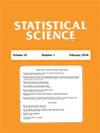空间点模式的扩散平滑
IF 3.9
1区 数学
Q1 STATISTICS & PROBABILITY
引用次数: 0
摘要
传统的核方法用于估计空间点模式中点的空间变化密度,除了常见的偏差和过平滑或欠平滑问题外,还可能出现不切实际的伪影。使用扩散平滑可以提高性能,其中平滑核是空间域上的热核。本文将扩散平滑发展成为一种实用的二维空间点图数据统计方法。我们阐明了扩散平滑相对于高斯核平滑的优缺点。自适应平滑,其中平滑带宽是空间变化的,可以通过采用空间变化的扩散速率来实现,这避免了自适应高斯平滑的技术问题,并且具有更好的性能。我们引入了一种新的使用滞后到达时间的自适应平滑形式,它具有良好的性能和增强的鲁棒性。演示了在考古学和流行病学中的应用。这些方法是在开源的R代码中实现的。AMS 2000学科分类:初级62G07;二次62 m30。本文章由计算机程序翻译,如有差异,请以英文原文为准。
Diffusion Smoothing for Spatial Point Patterns
Traditional kernel methods for estimating the spatially-varying density of points in a spatial point pattern may exhibit unrealistic artefacts, in addition to the familiar problems of bias and overor undersmoothing. Performance can be improved by using diffusion smoothing, in which the smoothing kernel is the heat kernel on the spatial domain. This paper develops diffusion smoothing into a practical statistical methodology for two-dimensional spatial point pattern data. We clarify the advantages and disadvantages of diffusion smoothing over Gaussian kernel smoothing. Adaptive smoothing, where the smoothing bandwidth is spatially-varying, can be performed by adopting a spatiallyvarying diffusion rate: this avoids technical problems with adaptive Gaussian smoothing and has substantially better performance. We introduce a new form of adaptive smoothing using lagged arrival times, which has good performance and improved robustness. Applications in archaeology and epidemiology are demonstrated. The methods are implemented in open-source R code. AMS 2000 subject classifications: Primary 62G07; secondary 62M30.
求助全文
通过发布文献求助,成功后即可免费获取论文全文。
去求助
来源期刊

Statistical Science
数学-统计学与概率论
CiteScore
6.50
自引率
1.80%
发文量
40
审稿时长
>12 weeks
期刊介绍:
The central purpose of Statistical Science is to convey the richness, breadth and unity of the field by presenting the full range of contemporary statistical thought at a moderate technical level, accessible to the wide community of practitioners, researchers and students of statistics and probability.
 求助内容:
求助内容: 应助结果提醒方式:
应助结果提醒方式:


